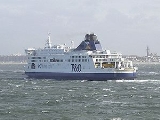
Pride of Kent
Encyclopedia
MS Pride of Kent is a cross-channel ferry
operated by P&O Ferries
, generally on the Dover
to Calais
service.
' of the P&O Dover-based fleet. Colloquially known as the Kent, she was built as the European Highway in 1991, a sister ship to the MS Pride of Canterbury, MS Pride of Burgundy and MS European Seaway. Originally servicing Zeebrugge
, like the Pride of Canterbury, she was converted in 2003 before re-entering service on the Dover–Calais route as the Pride of Kent.
She is the second ship to bear the name — was renamed Pride of Kent in 1987 (later P&OSL Kent in 1998 and PO Kent in 2002) and continued to sail the Dover-Calais route until 2003.
(formerly European Pathway)
Pride of Kent and Pride of Canterbury are commonly known as the 'Darwin Twins' or 'Darwins' after the project name given by P&O to the conversion of the ships.
Ferry
A ferry is a form of transportation, usually a boat, but sometimes a ship, used to carry primarily passengers, and sometimes vehicles and cargo as well, across a body of water. Most ferries operate on regular, frequent, return services...
operated by P&O Ferries
P&O Ferries
P&O Ferries is the current name for the amalgamation of a range of ferry services that operated from the United Kingdom to Ireland and Continental Europe...
, generally on the Dover
Dover
Dover is a town and major ferry port in the home county of Kent, in South East England. It faces France across the narrowest part of the English Channel, and lies south-east of Canterbury; east of Kent's administrative capital Maidstone; and north-east along the coastline from Dungeness and Hastings...
to Calais
Calais
Calais is a town in Northern France in the department of Pas-de-Calais, of which it is a sub-prefecture. Although Calais is by far the largest city in Pas-de-Calais, the department's capital is its third-largest city of Arras....
service.
History
Pride of Kent is the current 'flagshipFlagship
A flagship is a vessel used by the commanding officer of a group of naval ships, reflecting the custom of its commander, characteristically a flag officer, flying a distinguishing flag...
' of the P&O Dover-based fleet. Colloquially known as the Kent, she was built as the European Highway in 1991, a sister ship to the MS Pride of Canterbury, MS Pride of Burgundy and MS European Seaway. Originally servicing Zeebrugge
Zeebrugge
Zeebrugge is a village on the coast of Belgium and a subdivision of Bruges, for which it is the modern port. Zeebrugge serves as both the international port of Bruges-Zeebrugge and a seafront resort with hotels, cafés, a marina and a beach.-Location:...
, like the Pride of Canterbury, she was converted in 2003 before re-entering service on the Dover–Calais route as the Pride of Kent.
She is the second ship to bear the name — was renamed Pride of Kent in 1987 (later P&OSL Kent in 1998 and PO Kent in 2002) and continued to sail the Dover-Calais route until 2003.
Layout
The Pride of Kent has six 'active' decks - cardeck 3 freight and cars, cardeck 5 freight and cars, cardeck 6 cars only, deck 7 & 8 passenger facilities and deck 9 outside deck area. The ship is both divided vertically (as decks) and horizontally, into 3 ventilation zones, with stairs assigned the colours red, yellow, orange, green and blue. There are three passenger lifts from the main and car decks to the passenger facilities. Her onboard facilities include (amongst others) several lounges, a self-service cafeteria "The Food Court" (the former company branding for this facility was 'International Food Court'), 2 'Costa Coffee' cafés (one previously operated as Cafe Olliveto's until 2004), a Langan's Brasserie restaurant, a French duty-paid shop ("Offshore Shopping") and a bar previously branded as "Silverstones Sports Bar". There are also open decks on levels 8 and 9. Since June 2006, the interior passenger accommodation has become non-smoking throughout, with smoking permitted in designated parts of the outside deck 9 only.Sister ships
As built, Pride of Kent was identical to European Seaway and European Pathway. The fourth 'European Class' freight ferry was converted to a multi-purpose vessel for the Dover-Calais route and named , though she still retained a number of similarities. Following conversion to multi-purpose ship Pride of Kent is nearly identical to the .(formerly European Pathway)
Pride of Kent and Pride of Canterbury are commonly known as the 'Darwin Twins' or 'Darwins' after the project name given by P&O to the conversion of the ships.

